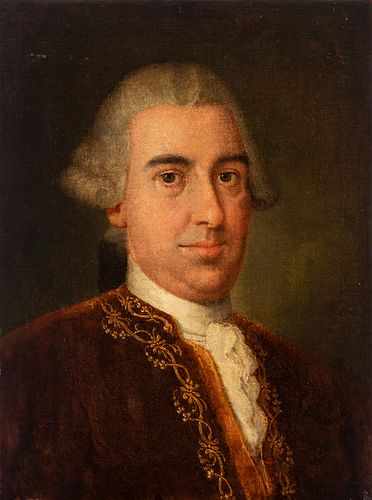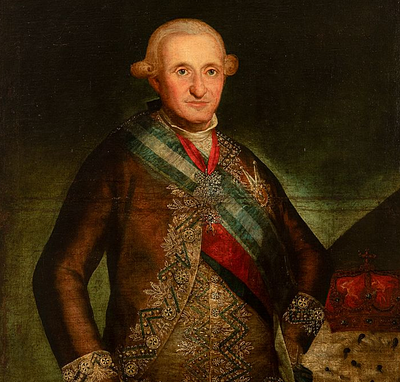Spanish school; circa 1780. "Portrait of a gentleman. Oil on canvas. Relined
Lot 34
About Seller
Setdart Auction House
Carrer Aragó 346
Barcelona
Spain
Setdart Subastas was born in 2004 and is currently the first online art auction in Spain with solidity, prestige and reliability guaranteed by our more than 60,000 users. Setdart has a young, dynamic and enterprising team ready to successfully manage the purchase and sale of art works through custom...Read more
Estimate:
EUR€1,500 - EUR€2,000
$1,562.50 - $2,083.33
Absentee vs Live bid
Two ways to bid:
- Leave a max absentee bid and the platform will bid on your behalf up to your maximum bid during the live auction.
- Bid live during the auction and your bids will be submitted real-time to the auctioneer.
Bid Increments
| Price | Bid Increment |
|---|---|
| EUR€0 | EUR€10 |
| EUR€200 | EUR€25 |
| EUR€500 | EUR€50 |
| EUR€1,000 | EUR€100 |
| EUR€3,000 | EUR€200 |
| EUR€5,000 | EUR€500 |
| EUR€10,000 | EUR€1,000 |
| EUR€20,000 | EUR€2,000 |
| EUR€50,000 | EUR€5,000 |
About Auction
By Setdart Auction House
Sep 22, 2021
Set Reminder
2021-09-22 09:30:00
2021-09-22 09:30:00
America/New_York
Bidsquare
Bidsquare : 22nd September - ARAS JÁUREGUI Private Collection - Old Masters, 19th & 20th Century
https://www.bidsquare.com/auctions/setdart-auction-house/22nd-september---aras-j-uregui-private-collection---old-masters-19th-20th-century-7427
ARAS JÁUREGUI Private Collection - Old Masters, 19th & 20th Century Setdart Auction House sofia@setdart.com
ARAS JÁUREGUI Private Collection - Old Masters, 19th & 20th Century Setdart Auction House sofia@setdart.com
- Lot Description
Spanish school; circa 1780. "Portrait of a gentleman. Oil on canvas. Relined It presents repainting. Measurements: 53 x 39 cm. This work presents similarities with the aesthetics of the painter Antonio Carnicero Mancio (Salamanca, 1748 - Madrid, 1814). Painter and engraver, son of the Baroque sculptor Alejandro Carnicero, he was also an excellent miniaturist. He entered the San Fernando Academy in Madrid at the age of ten and accompanied his brother Isidro to Rome. He remained in the Italian capital for six years, perfecting his art and taking part in various artistic competitions, winning prizes in several of them. On his return to Spain he completed his training at the Madrid Academy. Around this time he began to collaborate with José del Castillo, with whom he worked from 1775 onwards on tapestry cartoons for the Royal Factory, intended to decorate the rooms of the Princess of Asturias in the palace of El Pardo. As a draughtsman he illustrated the editions of Don Quixote published by the Royal Spanish Academy in 1780 and 1782. In 1790 he made preparatory drawings for engravings, among them his outstanding series entitled "Tauromaquia". In 1796, after previous unsuccessful attempts, he was appointed Pintor de Cámara (Chamber Painter) to Charles IV. Between that date and 1799 he did the illustrations for the book "El Real Picadero", commissioned by Manuel Godoy, which he was nevertheless unable to complete. He also collaborated with the "Colección de trajes" (Costume Collection), a series on popular types in Spain, producing between 1778 and 1784 seven illustrations with typical characters from the Balearic Islands. His scenes of dancing and strolling, or the flights of Montgolfier balloons, are in the Rococo style. However, his portraits are more classicist, as can be seen in his "Portrait of Charles IV in Armour" and "Portrait of Manuel Godoy". Among the variety of styles and genres treated by the artist is an exceptional work, "The Allegory of Vigilance", with a moral theme, painted with dramatic contrasts of light and shade that anticipate the Romantic aesthetic of the sublime. In the 1780s Carnicero worked on a series of oil paintings with views of roads and ports, originally commissioned by Charles III from Mariano Ramón Sánchez, which reflects the sophisticated cultural and enlightened interest of the time in the historical, archaeological and geographical heritage of the country. During these years the painter was sent to Aranjuez as drawing teacher to Prince Ferdinand. In connection with this he served a month in prison in 1806, following the incidents of the so-called "Prince's trial". However, after his imprisonment he agreed to remain in his post as Painter to the King. The usurpation of Joseph I Bonaparte led to his fall from grace, but after the restoration of Ferdinand VII's government he was restored to his post. Butcher is represented in the Prado Museum, the Madrid Municipal Museum, the San Fernando Academy, the Lázaro Galdiano Museum in Madrid and the Bilbao Fine Arts Museum, among others.
- Shipping Info
-
In-house shipping available. Please inquire at admin@setdart.com.
-
- Buyer's Premium



 EUR
EUR CAD
CAD AUD
AUD GBP
GBP MXN
MXN HKD
HKD CNY
CNY MYR
MYR SEK
SEK SGD
SGD CHF
CHF THB
THB














